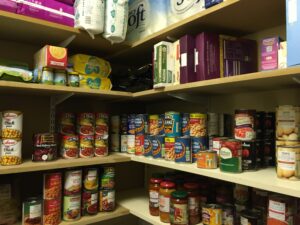Foodbanks in School
Food Banks in Schools
The Repair-Ed team met with Dr Will Baker today, who is leading research on the rise of Food Banks in schools in the UK. Some of his research takes place in Bristol, so we asked him about what this means for schools and communities in the city.

Thanks Will for speaking with me today. We’d love to share your research with our readers. Can you tell us how your work on food banks in UK schools came about and what it involves?
Will Baker:
Thank you for having me. I’ve been doing research in Bristol for last four years. I’ve lived in Bristol for over a decade, and it was really important to me when I got a job at the University that I was working in areas grounded in Bristol. During the pandemic, I started doing a project looking at Children’s Centres across the city and how they were supporting marginalised and vulnerable families. Obviously, that was an incredibly challenging time. Children’s centres were helping people going through mental health crises, people who were living in inadequate housing, people facing domestic violence… and one of the things that I became very aware of and very interested in was how children centres were also supporting families with food, baby milk and other essentials. Children’s centres did a huge amount of work during the pandemic, creating food clubs and doing food-drops around to people’s houses. Providing families with basic essentials connected to food become one of the core ways in which city institutions actually responded to the pandemic. So that was where the project I’m currently doing now around food banks and food justice and charitable food aid in schools comes from.
Can you tell us what you mean by charitable food aid?
Charitable food aid is when schools provide food directly to families through their own food bank or food pantry. So it’s distinct from breakfast clubs and free school meal provision. Food banks in schools come in all sorts of shapes and sizes, from small little food banks that are primarily funded by staff or supplied by staff to much larger scale ones that might serve 40 or 50 students a week. I was in a school in Bristol last week – a secondary school – they run a food bank entirely supplied by donations from the staff. The head teacher would go out to Sainsbury’s or Tesco and the end of the night, buy a bunch of food, put it into bags, and then do bag drops around to various families that need it. A lot of schools rely on staff and parents to donate money or food. And quite a lot of them have teamed up with supermarkets or FareShare to get fresh food and veg that would otherwise go to waste. So there’s quite a few different models I would say.

You’ve had some new research come out which has a pretty striking headline. Can you tell us about that and other striking findings that you’ve come across through the course of your work?
I would say the most striking thing was becoming aware the extent to which schools are doing this work and how there’s so many kinds of school-based food banks. I was quite shocked and then surprised just how big an issue this was. The statistics are equally shocking. We’ve got three and a half million kids that experience food insecurity and one in five kids live in low-income households across the UK. So the scale of the issue is shocking, and obviously it has got a lot worse during the cost of living crisis.
One thing that I’ve found out recently through survey data from my research is that one in five schools in England now run a food bank. That’s over 4,000 school-based food banks. And if you compare that to the number of Trussell Trust and independent Food aid network food banks, the number of school-based food banks is now substantially higher than food banks outside of schools. So for me that represents a very large social failure and also a really big change in how schools support families now.
It’s definitely been the case that schools have always worked very hard or been engaged in supporting low-income and working-class families struggling with food. But I think the scale of the issue is new and I think the sense that it’s the responsibility of schools to do something about it is quite new as well.
As you know, the Repair-Ed Project is focused on Bristol. Do you see any patterns or particular issues in your work that are emerging as significant for the city?
I think lots of the challenges we’re seeing across the city reflect some quite long-term processes. There’s been huge changes with how we fund organise and run our core institutions. And it’s not just education. If you look at the National Health Service…you look at trying to get a doctor appointment, you look at trying to get a dentist appointment, you look at the state of the roads or accessing mental health services. We’ve had a hollowing out of core aspects of the of the welfare state and I see that playing out across Bristol.
When I go into schools in Bristol but also across the country, teachers and school support staff talk about just how hard it is for families to make ends meet. And I think these are large scale structural patternings. Our labour markets are arranged around insecure, low paid work. Our welfare system is dysfunctional insofar as it doesn’t provide people with a financial means to be able to heat their homes and feed their kids. The inequality in Bristol is spatially patterned too. Poverty comes in different forms, and works in different ways across different parts of the city.
We need to ask, what are the needs that we face as society and are we funding our core institutions properly? Sometimes the government says, “oh, school funding’s at record levels” but it’s not been often keeping up with inflation. It’s not been tracking the needs of the school. It’s not been tracking the needs of the parents. I see this playing out across Bristol. And I’m deeply worried because I think it’s manifestly unjust that so many kids across the city are not being supported in their in their education.
Reflecting on your research, what do you think a just education system looks like?
Our core institutions are arranged and organised in such a way that they consistently lead to marginalisation, oppression and exclusion and inequality. So I very much connect my work on food banks to a broader analysis of structural injustice.
So, in terms of what I think a just education systems looks like… one of the core challenges we face is a raw lack of financial resources going into schools, neighbourhoods and families – through the education system, the welfare system, and the labour market. So I think we need to have a very long term strategy about how to address that – to give humane levels of funding to our core institutions so people can live dignified lives.
Resources are one thing but it’s also about addressing social arrangements where people aren’t allowed to stand in relations of equality to one another. I guess I’m some kind of relational egalitarian who is deeply suspicious of social arrangements where there are arbitrary hierarchies of status, dignity, and respect. So for me, a just education system is not just about funding, but is about people standing in relationships of equality to one another.
It’s about recognising tht everyone is equal here and everyone has equal say in these issues. I think for me that’s an important part of what a socially just education system looks like. In the broadest possible terms, I think it means a fundamental redistribution of all sorts of kind of resources to the most disadvantaged.
You can read more about Will’s work on food banks in schools here, here and here
